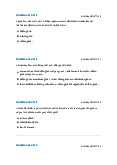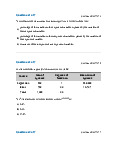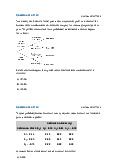















Preview text:
Question #1 of 56 Question ID: 1377567
Total investment is one of the components of a country's GDP. Which of the following is
least likely to be considered a source of funds for investment? A) National savings. B) Foreign borrowing. C) Household expenditures. Question #2 of 56 Question ID: 1377592
From an initial long-run equilibrium, if aggregate demand increases while short-run
aggregate supply decreases, the price level: A) may increase or decrease. B) will increase. C) will decrease. Question #3 of 56 Question ID: 1377582
Which of the following choices best describes the effects on consumption, investment, and
net exports that would result from an increase in the price level, other factors held constant? Consumption Investment Net exports A) Decrease Decrease Decrease B) Decrease Increase Increase C) Increase Increase Increase Question #4 of 56 Question ID: 1377554
If the GDP deflator is less than 100, then real GDP is: A) greater than nominal GDP. B) less than nominal GDP. C) equal to nominal GDP. Question #5 of 56 Question ID: 1377577
Which of the following factors is most likely to increase aggregate demand?
A) An expected decrease in future prices. B) An increase in real wealth.
C) Increasing real interest rates. Question #6 of 56 Question ID: 1377591
Can an economy that is at long-run equilibrium adjust to produce real GDP which is greater
than full-employment real GDP in the short run? A) No.
B) Yes, if aggregate demand increases. C) Yes, if wages increase. Question #7 of 56 Question ID: 1377560
The difference between personal income and disposable income is: A) xed expenses. B) savings. C) taxes. Question #8 of 56 Question ID: 1377599
When the sources of economic growth are stated as a production function, which factor is treated as a multiplier? A) Size of the labor force.
B) Amount of capital available. C) Productivity. Question #9 of 56 Question ID: 1377552
Which method of calculating gross domestic product requires data from each stage of production of goods?
A) Value of nal output method. B) Income method. C) Sum of value added method. Question #10 of 56 Question ID: 1377583
Which of the following is most likely to occur in the short run aggregate demand decreases
due to a reduction in business and consumer optimism?
A) A higher rate of ination. B) An increase in real GDP.
C) An increase in the rate of unemployment. Question #11 of 56 Question ID: 1377562
An economist calculates the following value:
National income + transfer payments to households − indirect business taxes −
corporate income taxes − undistributed corporate profits
The most appropriate term for the value she has calculated is: A) GDP. B) personal income. C) disposable income. Question #12 of 56 Question ID: 1377578
Which of the following factors is most likely to increase long-run aggregate supply? A) Wage rates increase.
B) The average rate of labor productivity increases. C) Aggregate demand decreases. Question #13 of 56 Question ID: 1377569
Which of the following statements concerning aggregate demand is most accurate?
A) When price levels rise, real wealth decreases, and individuals will spend less.
B) When price levels fall, real wealth increases, and individuals will spend less.
C) When price levels rise, real wealth increases, and individuals will spend more. Question #14 of 56 Question ID: 1377576
When national income in an important trading partner's economy increases, aggregate
demand in the domestic economy is most likely to:
decrease because foreign consumers will tend to buy less export goods from the A) domestic country.
increase because foreign consumers will tend to buy more export goods from the B) domestic country.
C) decrease because interest rates in the domestic economy will tend to increase. Question #15 of 56 Question ID: 1377579
Which of the following events is least likely to cause a decrease in short-run aggregate supply?
A) A labor stoppage causes the price of steel to rise.
B) Ination increases from 4% to 7%.
C) Oil exporting countries reduce their production levels. Question #16 of 56 Question ID: 1377556
If nominal GDP is $562 billion and the GDP deflator is 119, real GDP is closest to: A) $47 billion. B) $5 billion. C) $472 billion. Question #17 of 56 Question ID: 1377566
If the government is running a budget deficit, which of the following relationships are least
likely to occur in the economy at the same time? Exports relative to Savings relative to imports investment private savings < private A) exports > imports investment private savings > private B) exports < imports investment private savings < private C) exports < imports investment Question #18 of 56 Question ID: 1377600
The production function approach to explaining economic growth focuses on:
A) productivity, the labor force, and the capital stock.
B) shifts in the aggregate demand and supply curves.
C) the eects on producers of scal and monetary policy. Question #19 of 56 Question ID: 1377590
If the economy is in short-run disequilibrium below full employment, the most likely explanation is that:
A) aggregate demand has decreased.
B) long-run aggregate supply has decreased.
C) money wage rates have decreased. Question #20 of 56 Question ID: 1377602
Over the last five years, in the country of Midlothian, both the labor supply and the real
stock of physical capital have increased by 20% and real GDP increased 22%. The reason that
real GDP growth was greater than input growth over the period is most likely that:
A) total factor productivity increased.
B) the production function is multiplicative. C) money wages decreased. Question #21 of 56 Question #21 of 56 Question ID: 1377551
A shirt with a retail price of $50 is produced using cloth with a value of $40. The cloth is
produced from cotton with a value of $30. Using the sum-of-value-added method, what is
the total value added to gross domestic product by producing the shirt? A) $70 B) $20 C) $50 Question #22 of 56 Question ID: 1377571
An increase in real interest rates can be expected to:
A) decrease investment and decrease consumption.
B) decrease investment and increase net exports.
C) increase government spending and decrease consumption. Question #23 of 56 Question ID: 1377589
An increase in aggregate demand can result in output greater than potential GDP in:
A) neither the short run nor the long run.
B) the short run and the long run. C) the short run only. Question #24 of 56 Question ID: 1377570
Which of the following is least likely a reason that the aggregate demand curve slopes downward?
A) Business investment declines as a rising price level increases interest rates.
Because entitlements are adjusted for ination, a rising price level forces B)
government spending to increase.
C) The wealth eect causes consumers to spend less when the price level rises. Question #25 of 56 Question ID: 1377548
Gross domestic product includes the value of all goods:
A) produced and purchased during the measurement period.
B) produced during the measurement period.
C) purchased during the measurement period. Question #26 of 56 Question ID: 1377596
The sustainable growth rate of an economy is best viewed as the sum of the growth rates of:
A) the labor force and productivity.
B) private and government spending. C) consumption and investment. Question #27 of 56 Question ID: 1377573
The long-run aggregate supply curve is best described as:
A) elastic because most input prices are variable in the long run.
B) perfectly elastic because input prices are sticky in the long run.
perfectly inelastic because input prices change proportionately with the price level in C) the long run. Question #28 of 56 Question ID: 1377584
A reduction in short-run aggregate supply is most likely to be accompanied by an increase in: A) real GDP. B) real interest rates. C) the price level. Question #29 of 56 Question ID: 1377581
Which of the following events is most likely to increase short-run aggregate supply (shift the curve to the right)?
A) An increase in government spending intended to increase real output.
B) High unemployment puts downward pressure on money wages.
C) Ination that results in an increase in goods prices. Question #30 of 56 Question ID: 1377572
The long-run aggregate supply curve is:
A) elastic because input prices are sticky.
B) inelastic because all input prices can vary.
C) perfectly elastic because input prices are xed. Question #31 of 56 Question ID: 1377574
Because some input prices do not adjust rapidly to changes in the price level, the short-run aggregate supply curve:
A) exhibits a negative relationship between quantity supplied and the price level.
B) is more elastic than the long-run aggregate supply curve.
C) may be interpreted as representing the economy’s potential output. Question #32 of 56 Question ID: 1377553
Compared to GDP calculated using the sum-of-value-added method, GDP using the value-of- final-output method will be: A) biased downward. B) biased upward. C) equal to it. Question #33 of 56 Question ID: 1377549
Which of the following least accurately describes a component of gross domestic product? A) Investment. B) Consumption. C) Net imports. Question #34 of 56 Question ID: 1377561
Which of the following amounts is least likely to be subtracted from gross domestic product
in order to calculate national income?
A) Capital consumption allowance. B) Indirect business taxes. C) Statistical discrepancy. Question #35 of 56 Question ID: 1377565
If a fiscal budget deficit increases, which of the following factors must also increase if all
other factors are held constant? A) Savings. B) Investment. C) Trade surplus. Question #36 of 56 Question ID: 1377559
Under the expenditure approach, gross domestic product is the sum of:
national income and transfer payments to households, less corporate and indirect A)
business taxes and undistributed corporate prots.
consumption spending, gross private domestic investment, government spending, B) and net exports.
wages and benets, corporate prots, interest income, unincorporated business C)
owners’ income, rent, and indirect business taxes less subsidies. Question #37 of 56 Question ID: 1377594
If both aggregate demand and short-run aggregate supply decrease, the price level: A) may increase or decrease. B) will decrease. C) will increase. Question #38 of 56 Question ID: 1377597
Sources of long-run economic growth most likely include increases in:
A) government spending, labor supply, and physical capital.
B) labor supply, physical capital, and technology.
C) human capital, money supply, and natural resources. Question #39 of 56 Question ID: 1377547
A country's gross domestic product is:
A) equal to the country’s aggregate income.
B) greater than the country’s aggregate income.
C) less than the country’s aggregate income. Question #40 of 56 Question ID: 1377558
Components of national income include:
A) rent, interest income, and capital consumption allowance.
B) wages and benets, corporate prots, and indirect business taxes less subsidies.
government enterprise prots, unincorporated business net income, and statistical C) discrepancy. Question #41 of 56 Question ID: 1377580
Which of the following is most likely to cause an increase in aggregate demand?
A) An increase in the general price level.
B) High capacity utilization rates.
C) Relative appreciation in the country’s currency. Question #42 of 56 Question ID: 1377575
The sustainable growth rate of real GDP is most likely to be increased by:
A) an increase in the propensity to consume by households.
B) the discovery of untapped oil elds.
C) an increase in government spending. Question #43 of 56 Question ID: 1377601
Growth in total factor productivity is best described as driven by growth in: A) capital. B) labor. C) technology. Question #44 of 56 Question ID: 1377568
If domestic savings are insufficient to finance domestic private investment and exports are
greater than imports, it is most likely that the fiscal budget has:
A) a decit that is less than the trade surplus.
B) a decit that is greater than the trade surplus.
C) a surplus that is greater than the trade surplus. Question #45 of 56 Question ID: 1377557
The GDP deflator is the percentage difference between nominal GDP:
A) and real GDP in the current period.
B) and real GDP in the base period.
C) in the current period and real GDP in the base period. Question #46 of 56 Question ID: 1377587
Stagflation refers to an environment of:
A) High unemployment and low ination.
B) Low unemployment and high ination.



